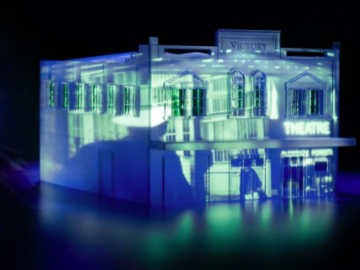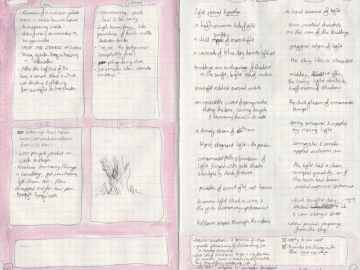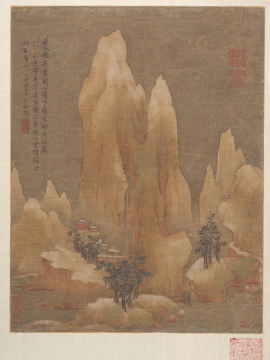Beyond Sight: A Personal History of Imaging
Verity Borthwick
For a long time, they’d known there was a hidden world of sickness. But it was not until a Dutch draper, a lens grinder, peered through one of the first microscopes and drew pictures of his ‘animalcules’—meaning little animals in Dutch—that we truly started to understand the breadth of life on this planet. Imagine the amazement when he first saw these alien creatures swim into focus beneath the lens. What sudden power to warp the world in this way, to bend light and allow us to see the tiniest of things.
I culture the Bacillus Cereus from fried rice I bought at the university food court. Scrape it out on the agar plate to separate the colonies and I am thrilled when they bloom. Under the microscope they appear as purple rods, clustered together in shapes that almost look like malformed letters. I isolated these microbes. I grew them, and I am as proud as a gardener holding out their perfect rose.
*
You have looked small, now it’s time to look far. Turn your gaze to the stars and you cannot believe the things you shall see. The moon comes into focus, and there is the landscape laid bare, hills and valleys, imagine taking a stroll in that empty place. Men will one day, centuries later, and though gravity’s hold is light here, their footprints will stay until the moon is no more.
The telescopes will increase in size until they are giant, perching on hilltops, cyclops eyes pointed into the galaxy. We will send them into space where they will hover in the vacuum, huge golden creatures with solar panel wings outspread and what treasures they will return to us—clouds of gas birthing new white light, galaxies swirling and thick with stars, the splintered remains of supernovae.
I am a child, and my Dad sets up the telescope in the backyard, on a clear and starscattered night. There wasn’t as much light pollution back then. He centres the telescope and tells me take a look. The moon fills the eyepiece, a mottled surface of dead volcanoes and craters and lava flows with beautiful names. It looks close enough to touch.
*
At first they didn’t know the danger, so they pressed the button over and over, made pictures of their bones on a screen for fun. Each hollow click sent X-rays streaming though the body until they hit bone. Think about this, the tiny path of destruction left in the wake of this invisible energy. About the workers with their blistered skin and bloodshot eyes. The damaged cells blossoming into cancers
Now think about the care taken when your own bones have been laid bare. I wear a lead-lined apron that weighs heavy on my torso. The radiologist is outside the room. My head is held in place with ear-pieces that dig in and hurt. Keep very still, they say, and the machine takes a panoramic X-ray of my jaw. The X-ray films look like a horror movie grin spread wide. My wisdom teeth are coming in perpendicular, invisible battering rams on either side of my smile.
*
An X-ray through a crystalline material makes a pattern like the traces of stars on a long exposure photograph of the night. These constellations tell you what you need to know about a structure, the way the X-rays have rattled through the crystal lattice, the angle at which they come through the other side
Make that X-ray more powerful: send the electrons hurtling round a ring almost a kilometre long. A machine so big the easiest way to get around is by bicycle. Send the beam right into the middle of a crystal, and on the other side you now have what you need to recreate a tiny hidden piece of the universe.
This is why I sit at the synchrotron in the middle of the night, trying to stay awake, checking the temperature readings, checking the images coming up on the screen. My tiny salt crystal is in the machine, behind a locked door with a radioactive symbol on it. At the end of each of the other beamlines a similar tired person sits, repeating my slumped pose before their own screen. Outside the town of Grenoble sleeps, and the mountains stretch above us, but here in the ring it is never truly night.
*
The sky crowds with bats, whirring this way and that and communicating with sounds we cannot hear. The Titanic sinks. The graveyard of an undersea ship, flaws in metallic structures, gallstones lying encased in an organ, these are things we cannot see. And so, they begin to use sound to peer into these shadow worlds.
The taut skin of my belly becomes see-through as sound ripples through my body and the echoes make shapes appear in the gloom. One day this geometry will reveal the thrum of a tiny heartbeat appearing as a white flicker. There will be another day in another year when there is no such heartbeat, and the monitor shows something that looks like a cocoon but is actually a shroud.
These are the most memorable, but there are many, many other times the black and white of my innards have been laid bare: the breast lumps that were thankfully benign, the pearl-like clusters of black cysts in my ovaries, the rush of saline through my fallopian tubes to determine the cause of the infertility.
*
Perhaps you think something is beautiful, but look closer, look smaller. Take that tiny thing and spray it with a coating of gold. Seal it inside a tomb-like machine and vent away the air. Marvel at what you have found, how something you thought you knew the shape of could have such intricacy, could become so delicate, so frightening when you magnify it in this way. Pollen grains become the garden Alice walked through in Wonderland. A flea is now a monstrous creature of nightmares. You can see each single hair on the head of a fly. The interior of your own bones looks like a honeycomb.
In a basement room in Stockholm, I sit at another screen. The hum of machinery is constant. Inside the scanning electron microscope, a slice of my salt crystal sits in its heating apparatus. I incrementally increase the temperature and shoot electrons at the surface to record the patterns produced when they backscatter. This will tell me how the crystal has changed as I heat it. Countless hours spent in that windowless room, but I never stop thinking that the patterns those electrons produce—Kikuchi bands—are beautiful. It’s like looking into a grey kaleidoscope.
*
In order to create this image, they will slide you into something that resembles a circular portal. On the other side is a world where your internal workings can be divined in crosssection slices. Here is your head, your gut, organs floating in the darkness of your body cavity, blood vessels branching like root systems. It’s said that the history of this technology lies in the music industry. The astronomical profits from The Beatles albums would fund the research for a new type of imaging.
It seems fitting; my dad has always been a Beatles fan. The slices of his organs show the thyroid cancer nestled grey and soft in his neck, so they excise it, and he swallows a radioactive pill and sits alone in a room for four days. The thyroid cancer is gone, the thyroid itself is gone, but his other cancer is still there and thankfully does nothing. And every second year he goes back through that portal, and we cross our fingers that the world on the other side holds good news.
Feature image via 'Art Collection - The Metropolitan Museum of Art'


